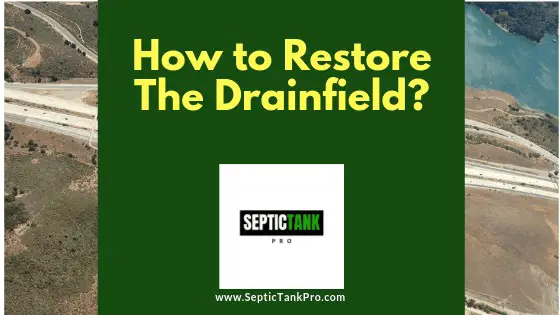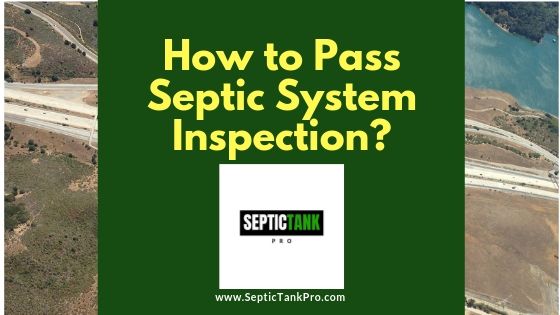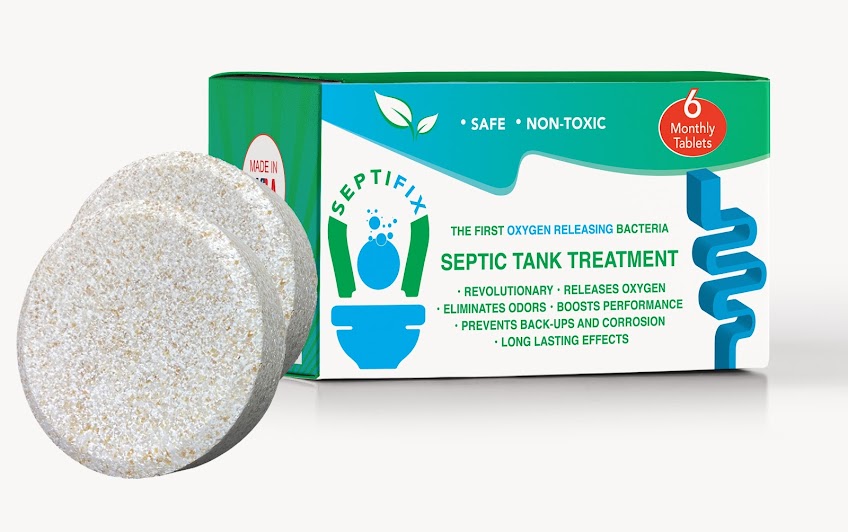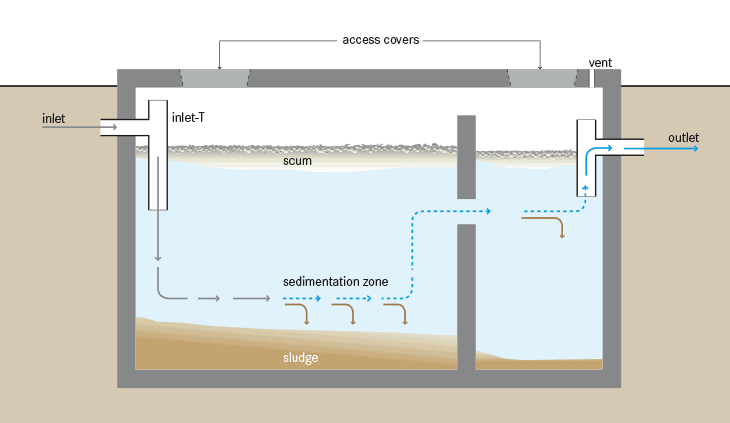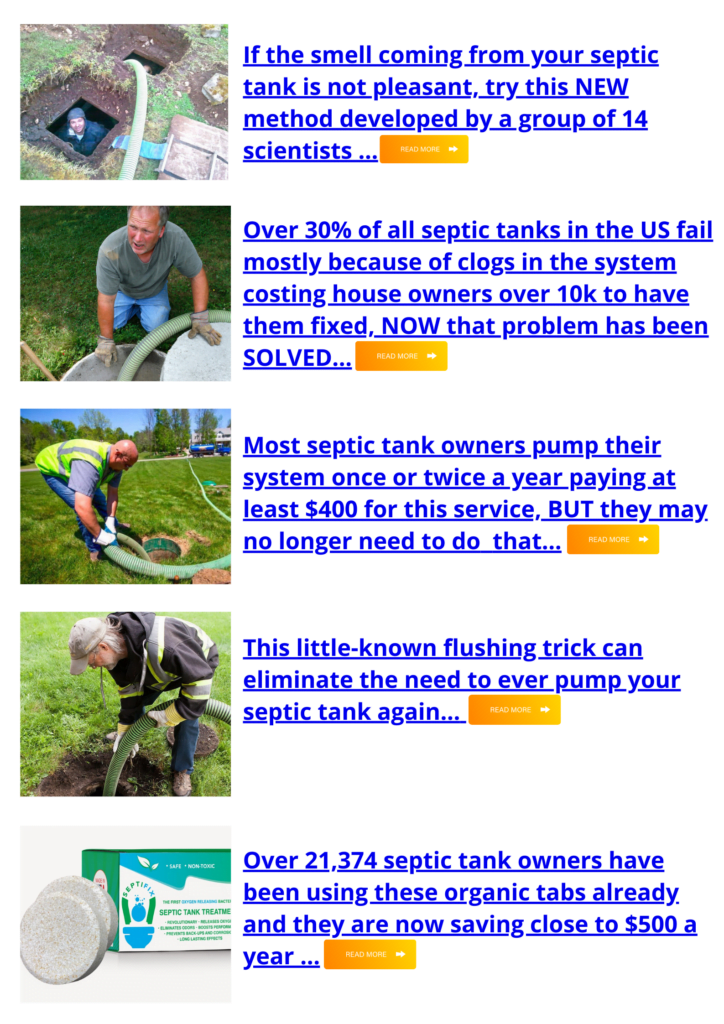How To Restore A Septic Drainfield
An adeptly-designed, properly-installed, and well-maintained septic system should last you for decades. Unfortunately, it can likewise fail in just a few years, with any of the three aforementioned elements lacking. Practically speaking, maintaining a healthy septic system is not all that expensive, but you could easily spend thousands to excavate and replace a system that has failed. Good maintenance practices are rooted in an adequate understanding of how a septic system operates and just how it can be a potential cesspool (no pun intended) of problems. Let’s take a quick review of what’s supposed to happen in a fully functioning septic system, focusing on one of its main components: the septic drainfield.
Need Help With Your Septic DrainField?
Fill out the Septic Service Request Form Below and Someone Will Be In Touch Soon…
The drainfield, or soil absorption system, is a series of perforated pipes or chambers buried underground that channel the pre-treated wastewater, otherwise known as effluent (the liquid discharge from your septic tank). The effluent from the septic tank travels to the drainfield where the effluent is moved gradually down through the soil, allowing for natural purification, before it is released back into the aquifer. An aquifer is an underground layer of water-bearing permeable rock, rock fractures or unconsolidated materials (gravel, sand, or silt). Although your septic tank holds out most of the heavier solid wastes (scum and sludge) and breaks them down to virtually half, the effluent (clear middle layer) still has a high amount of biodegradable organic matter with high bacterial content. Your septic drainfield acts as a natural filter for effluent as it absorbs organic matter, further reducing or removing pathogens, making it safe to be assimilated into groundwater. This critical function of removing pathogens and safely disposing treated wastewater through subsurface soil absorption is what makes the health of the drainfield a crucial concern for all septic system owners. If your septic drainfield starts showing indications of failure, you will need to restore it immediately.
One of the first and most obvious indications of a failing drainfield is surfacing effluent. If the soil’s ability to accept the effluent being delivered is diminished, the effluent will either rise to your ground’s surface, or even ‘blow out’ at the end of the field’s trenches. This compromised capacity of the soil to accept the pre-treated effluent is most often due to the biomat formation. As the effluent enters the drainfield, bacterial growth in the soil is promoted due to the new “food source”. As these bacteria grow, a thick slimy colony called the biomat is formed and this restricts the flow of effluent to the surrounding soil. If there is a clog in your drainfield, you need to subject the drainfield to repairs, and you need to do it soon. To restore the septic drainfield you will likely need to check your septic tank for possible clogs, as well as take corrective steps to prevent the drainfield from becoming clogged again down the line. A drainfield that has been left untreated over a number of years, especially if non-biodegradable substances (like grease and oil) are constantly flushed into it, is susceptible to clogging.
Rehabilitating Your Drainfield: Short-term Solutions
If you find yourself in the unfortunate situation where your drainfield is failing, but let’s say your vicinity is soon to gain access to the centralized public sewer system, you would be better off resorting to a short-term fix like water conservation. Although, bear in mind that drainfield failure must be considered a serious health hazard and water conservation is not really a definitive solution. But sometimes, an overloaded drainfield may recover if stringent water conservation practices are adhered to by the property owner and all building occupants. Besides best practices such as spacing out dishwashing and laundry loads, you may want to consider switching to water-efficient or low-flow toilets and fixtures. Conservative water usage reduces the output of effluent and, in turn, gives the soil around the drainfield piping time to dry out, possibly allowing it to function properly once again. This method obviously requires serious owner-and-occupant commitment. It typically takes about a 30% reduction in total water usage for there to be any significant impact to drainfield recovery.
There now are some relatively new technologies that may provide temporary relief to afailing drainfield. The first is what we call “jetting”. This procedure utilizes special pumps to inject water into the drain lines in high pressure to break up silt and other deposits. There is necessarily a powerful vacuum line, too, that can suck out the broken-up deposits out of the lines to avoid re-settling. A sewer jetter can help you break down sludge and flush them out along with any residue. This helps to reduce the need for subsequent cleaning of your lines, too. To make the task easier, power the sewer jetter with a gas pressure washer rated 2.0 to 4.0 GPM (gallons per minute). Lower GPM’s from a smaller electric machine will not be suitable for cleaning septic drainfields. It is ideal that you locate and expose (through digging) the downhill end of each septic line by digging a large-enough hole under each end to allow the sludge to flow out and be collected as you clean the opened line.
An alternative approach would be to locate and expose your system’s distribution box and then feed the sewer jetter through each line that exits the box. To review, a septic system’s distribution box functions to evenly distribute the wastewater into the drainfield, typically aided by gravity. Wastewater flows downhill where the distribution box is located and is then distributed out to the drainfield lines. Note that the size and shape of your distribution box depends on the type of septic tank you have. Distribution boxes are most commonly made of concrete or plastic and will have several openings for the drainfield lines where the wastewater flows out of. Be advised, though, that it could be more difficult to thoroughly flush out the sludge uphill toward the opened distribution box as you’ll frequently need to pump out the residue that flows back into the box.
Now, if you clean your septic drainfield with a sewer jetter, you have to remember to:
- Wear fluid-resistant work gloves and eye protection (such as work goggles). Proceed with extra caution especially if you believe the lines might contain drain-cleaning chemicals.
- Connect the drain cleaner to your trigger gun, start the pressure washer, and then carefully guide the nozzle to at least a foot into the exposed septic line opening before you turn on the water flow.
- Guide the sewer jetter into the line as you squeeze the trigger. For more thorough cleaning, pull back about halfway every few feet before proceeding forward.
- Be careful not to release the trigger to stop the water before you’ve gotten the nozzle to the opening.
- Replace any fittings, check the system, and restore the dirt fill after you have completed the task.
If, for any reason, you suspect that there could be tree roots infiltrating your drainfield lines, you may be able to loosen the fine roots with a sewer jetter and then pull out the long root strings by hand or with a mechanical drum auger equipped with a root-cutting blade. Mechanical drum augers with cutting blades are certainly required for the larger tree roots that may have found their way into your drainfield lines. This equipment may be rented from providers. Once the roots have been cut, you can then flush the line with a sewer jetter to remove the sludge.
If the failure of your drainfield is caused by compacted soil conditions, temporary relief may come in the form of a technology known as “soil fracturing.” Specialized equipment with a pneumatic hammer drives narrow probes into the drainfield soil, typically to a depth range of 3 to 6 feet. Through these probes, air is then forced into the soil at a controlled rate, fracturing the hard soil, thus creating small open channels through it. Afterwards, polystyrene pellets are injected into the newly-aerated soil. These pellets will keep the channels open, preventing the soil from compacting again. Note, though, that this technology has netted mixed results and is only approved in certain states. You should first check with your local health department to find out about a similar process (if any) that is approved for your jurisdiction.
A known technique to rehabilitate a failing drainfield, preventing the need for a total septic system replacement, is to restore the beneficial bacteria in the drainfield. A septic service professional will need to pump out your drainfield system, including the distribution box. The distribution box would normally have a build-up of biomat which needs to be cleared out. The biomat, a bacterial slime layer in the soil just below the drainfield, is a critical component of on-site septic systems. The biomat is responsible for the treatment and reduction of organic solids and pathogens in septic effluent which is discharged into the drainfield from a septic tank. After this clean-out, about 4 gallons of septic shock bacteria is poured into the distribution box, which in turn will feed it into the drainfield. A gallon of this septic shock bacteria is typically applied to the sinks and drains inside the house or facility. Finally, there is about 1 to 3 weeks of waiting for the solution to really penetrate the drainfield, allowing it time to digest solid matter and biomat.
You should remember that merely aerating the entire system does not eliminate the sodium accumulation from the soil. Aeration systems can cost up to $1,500 and should be backed up by electricity at all times. Be warned that the toxic fumes inside the septic tank can be detrimental to one’s health. If you’re not comfortable performing any of these steps, hiring a septic service company could save you money in the long run.
In cases of physical damage to the drainfield, system restoration may require just the leveling of the distribution box or repairing crushed or broken pipes. If tree roots are the culprits of the drainfield disruption, these can be removed with specialized equipment. If you constantly find solid waste in your drainfield, this is a likely indication of broken or deteriorated baffles in your septic tank. Regular inspection of the tank should include the inspection of the baffles, as faulty baffles will allow solid waste to be transported to the drainfield (which, we now know, should not be the case). Faulty baffles need to be replaced or repaired promptly.
Rehabilitating Your Drainfield: Long-term Solutions
Sometimes, corrective measures or temporary solutions are not enough to restore a septic drainfield. In such cases, a new soil absorption system must be installed. Drainfields are ideally placed either in 1) a remote or isolated area of the property so the old system is not disturbed in the process or 2) in between the existing trenches (if space therein is adequate). These additional lines are to become part of an alternating drainfield system. A diversion valve is installed so that it will be possible to direct the flow from the septic tank to either of the two drainfields down the line. After the new drainfield is in place, the flow is diverted from the old drainfield. The latter is expected to naturally rejuvenate gradually over time that it can be used again in the future. The rejuvenation process of a drainfield placed on this “resting state” takes about 2 years to recover and requires naturally-occurring bacteria to decompose the biomat that has formed and restore the absorptive system to its near-original capacity. Your old drainfield can recover more quickly if you contract a septic pumper to open the field and remove as much of the ponded wastewater as can be managed. After you have installed a new drainfield where your effluent will be diverted to, you can switch back to the old drainfield after 2 years, and then switch back and forth between the two systems annually. This allows for a cycle of use-and-rejuvenate for both drainfields and should contribute significantly to preventing future failures.
Alternating drainfields are effective in providing relief for a failing septic system. A serial drainfield is made up of a series of trenches. The first trench comes out of the septic tank and has an overflow pipe that leads from the first trench downhill to the second trench. The perforated pipes allow wastewater to seep out the base. When a trench becomes clogged, wastewater cannot seep out anymore and will go to the top of the pipe and into the overflow pipe. The first trench must be completely filled up before water flows into the second trench and so on.
If an adequate area for a new drainfield is not available, but the old system is a trench system with at least 6 feet of undisturbed soil between the trenches, it will be possible to install replacement trenches interlaced between the old ones. However, if you are to take this route, it is important to keep the plumbing for the new and old systems entirely separate so that when one is functioning, the other drainfield’s plumbing has the opportunity to dry out.
Another approach for the significant reduction of organic load on the drainfield is to add an advanced treatment system such as an aerobic treatment unit or a sand filter. These systems utilize natural processes to treat wastewater and are frequently used to restore clogged up, failing septic tank-soil absorption units.
Typically, sand filters are used in the secondary stage of wastewater treatment after the solid wastes in raw sewage have been separated in the septic tank. Sand filters are beds of sand with depths of about 2 or 3 feet and are often enclosed in a liner. Sand filters receive partially-treated effluent in irregular doses, where it slowly trickles through the sand, collected in an underdrain, and then flows to further treatment and/or its final disposal. Sand filters are proven to be effective in the removal of suspended solids and are capable of handling heavy hydraulic loads. These two characteristics make sand filters particularly useful in the event of overloaded drainfields – either hydraulically (water) or biologically (biomat).
Aerobic Treatment Units (ATUs) are similar to septic tanks in that ATUs rely on natural processes to treat wastewater. The remarkable difference lies in an ATU’s need for oxygen to carry out the treatment process. ATUs rely on a mechanism to inject and circulate air inside the treatment tank so as to encourage the population of aerobic (oxygen-loving) bacteria. These microorganisms work to break down and digest the wastewater inside the aerobic treatment unit.
Why Do Drainfields Fail?
Drainfeld failure can be caused by several factors, including excessive rainfall, tree roots infiltrating the drain lines, or vehicles and heavy equipment driving over the system and damaging pipes. But the two most common causes are: hydraulic and biological overloading. Hydraulic overloading happens when too much water is allowed to an under-designed system. Biological overloading, on the other hand, is the result of high concentrations of organic matter in the effluent.
The installation of appliances, such as garbage disposals and dishwashers, are also factors that can significantly alter the quality of the wastewater being sent to the septic system. These appliances send increased amounts of solid wastes to the system, potentially causing biological overloading. Use these appliances in moderation, keeping in mind that a garbage disposal unit is not a waste receptacle.
Your septic tanks is where wastewater from your home or building is separated into three layers: solids that settle at the bottom (sludge), scum (lighter solids that float to the top), and the relatively clearer middle liquid called effluent. The settled solid sludge and lighter scum layer are decomposed by microorganisms. The middle layer or effluent leaves the tank and travels through a series of underground perforated pipes into your drainfield. In the drainfield, gravel and soil act as biological filters to remove pathogens from the wastewater as it sinks into the ground.
Typically, state health codes mandate the installation of an effluent filter in septic tanks, so it is important to comply. Without the effluent filter, solid waste particles could be allowed to pass into the perforated pipes and cause problematic, not to mention costly, clogs. This is likely to happen especially if you are allowing filter-clogging materials down your drains or toilets (such as grease, fat or food scraps). Extensive digging will likely be needed in order to clean and unclog the system if this is allowed to happen. Most effluent filters don’t need to be cleaned until the tank is pumped, which is typically every 3 to 5 years, so they are not that difficult to maintain.
This is why the use of garbage disposal units is not entirely ideal. A disposer unit does not break down food particles enough and thus can increase the amount of solid matter in your septic tank by as much as 50%. Flushing plastic materials, disposable diapers, paper towels, and other non-biodegradable items and tobacco will also definitely clog up your septic system.
The failure of a septic system can be caused by several factors, as well. If you would like to avoid having to deal with a malfunctioning drainfield, and thus the costly worry of a failed on-site dedicated wastewater treatment, you definitely need to watch out for these:
- Overloading your system with water. Home and property owners should know better than to be overwhelming a septic system with too much. Space out laundry loads over days throughout the week rather than having just one ‘wash day’ where you wash an entire laundry load within a 24-48 hour period. Likewise, if you have swimming pools or hot tubs, you had better divert drainwater from these away from the plumbing leading to your septic system.
- Disposing of non-biodegradable matter such as coffee grounds, cigarette filters, disposable diapers, sanitary pads, grease, and other synthetic substances into your septic system are the primary causes of clogging problems. Same goes for harsh or toxic chemicals.
- Allowing tree roots to infiltrate your drainfield and septic plumbing. Tree roots are naturally drawn to the high concentrations of nutrients in wastewater, but neglecting to curtail this growth can cause damage to your system.
- Driving vehicles and/or operating heavy machinery over the drainfield. Heavy equipment over your absorption field will compact the soil of your drainfield, thus compromising its natural percolating abilities. Avoid driving or parking vehicles over the drainfield, as well as building structures such as sheds over the area.
- The system’s lifespan. Typically, septic systems are designed for an average operational life of 20 to 30 years. As your system ages, the more it requires regular monitoring and maintenance. And you should expect the possibility of having to replace it as inevitable.
How Can You Tell If Your Drainfield is Failing?
The U.S. Environmental Protection Agency (EPA) defines septic system failure as “a condition where performance requirements are not met” in its Onsite Wastewater Treatment Systems Manual (2002). Typically, septic system failure is declared when wastewater is noted on the ground surface or if it’s backing up into the house’ or facility’s plumbing. When a drainfield fails, it has the potential to pollute nearby water resources, therefore endangering public health. Children are most vulnerable to these health risks because they are more frequently the ones who come into contact with the contaminated areas.
The drainfield (also known as leach field, absorption bed, disposal field or seepage field) is a major component of septic systems as it accepts and treats wastewater (or effluent) coming from the septic tank. The drainfield processes the effluent before it returns to natural aquifers beneath the earth’s surface. All septic systems rely heavily on the drainfield soil’s ability to absorb water.
Many people whose properties rely on dedicated septic systems may encounter problems such as foul odors, slow drains and toilets, gurgling sounds from the pipes, sewage back-ups, and sewage water pooling in the yard. They are quick to attribute these to issues with the septic tank. This, however, is not accurate. The most common cause of septic system problems and eventual failure is the septic absorption component – the drainfield – that’s become impermeable that it is no longer able to absorb wastewater into the soil.
You can tell that your drainfield is failing if you observe the following:
- Foul odors emanating from the septic tank and/or drainfield areas.
- Water and sewage from toilets, drains, and sinks backing up into the home or building.
- Slow flushing in toilets and/or slow draining in sinks or tubs.
- Gurgling sounds coming from the building’s plumbing.
- Puddling water or damp spots near or around the septic tank or drainfield areas.
- Exceptionally lush grass or vegetation patches especially over the septic tank or drainfield, even during dry weather.
- High concentrations of nitrates or coliform bacteria in water wells.
- Algal blooms in nearby ponds or lakes. This is the rapid growth of microscopic algae or cyanobacteria in water, typically resulting in colored scum appearing on the water’s surface.
A malfunctioning or failing septic system causes untreated (raw) sewage to be released and transported to where it shouldn’t be, endangering humans, animals, and, of course, the environment. A responsible septic owner is alert to the signs of septic system failure, regardless of the age of his system, and is able to address the issues promptly upon early observation. Immediate response to any indication of septic system failure may save the property owner money in repairs or replacement and, more importantly, could prevent illness among those living around and other negative implications to the environment.
How Long Do Drainfields Last and How to Maintain Them
Drainfields are designed, constructed, and installed according to the type of soil and the soil percolation rate present on the property. You might even encounter raised drainfields that facilitate the absorption and evaporation processes of effluent. Even if septic drainfields are made differently, their life cycle really depends on the care and maintenance practices that the entire septic system is subjected to. If your septic tank is well-cared for – regularly pumped, inspected periodically, and receive helpful treatments monthly – then you could be assured of a drainfield that will last for as much as 50 years or more. On the other end, if the septic components and pipes were not installed properly, a drainfield can last just 24 hours at most. On average, a conventional drainfield has a lifespan of about 25 years, conservatively speaking and with proper care.
The adequate maintenance of your drainfield begins with monitoring water consumption and water usage practices in the home or facility. Likewise, a huge factor is what’s generally allowed into your septic system. Drainfield malfunction is a serious problem that needs to be addressed in a timely manner. If this is neglected, the drainfield could put everyone’s health and safety at definite risk.
Most septic system failures are caused by problems with the drainfield. The entire septic system relies on the drainfield to filter and dispose of wastewater. Now, when wastewater or solid waste builds up on the soil at the base of the drainfield, the soil clogs up and thus unable to drain properly. Common causes of drainfield malfunction include:
- Allowing harsh chemicals, grease, paint, and other similar complex substances you’re your drains and toilets.
- Excessive water usage in the building, including leaking faucets, toilets, and other water fixtures.
- Water runoff from heavy snow or rainfall.
- Damage from heavy vehicles, machineries, or structures over the drainfield.
- Infiltration to sewer plumbing by tree or large plant roots.
- System age.
Additionally, another main factor that can cause drainfield malfunction is the failure to have your septic tank pumped on regular intervals. Sludge and scum contents need to be cleared out periodically. On average, a septic tank should be pumped every 3 to 5 years, but actual frequency of required pumping will depend on how big the septic tank is and the size of the household.
A septic system that was properly designed and installed needs only occasional pumping to remove the sludge and scum from the tank. But without responsible or conscientious practices by property occupants, your septic system can be susceptible to harm and, yes, total failure. What follows are notes on what to avoid and what to watch out for if you would like to maximize your drainfield’s longevity.
- Waste that decomposes slowly (or, worse, not at all) flushed down drains and toilets like cigarette butts, diapers, sanitary pads, coffee grounds, and other non-biodegradable matter are leading causes of septic problems due to clogging.
- Garbage disposal units, especially when used excessively, can send too much solid waste into the septic system, hampering natural flow processes. Also, high levels of solid waste likely result to too much sludge. Very thick sludge levels in the septic tank reduces bacteria’s ability to digest them. Excess sludge can also overflow into the drainfield. Remember, too, that sludge and scum can plug up crevices in pipes.
- Allowing lint from synthetic fibers to flow from your washing machines are potentially problematic. The natural bacteria in the septic tank and drainfield will be unable to digest these.
- A number of common household chemicals like disinfectant cleaners, detergent, and antibacterial soaps kill the helpful bacteria that otherwise naturally thrive in septic systems. Most systems can handle light to moderate use of these products, but in this case, less is always better.
- Overwhelming your septic tank with too much water volumes will tend to flush out the tank too rapidly. Time is needed to effectively separate the sludge and scum from the effluent before it should leave the tank for the drainfield. Rapid flushing of the tank may allow raw sewage (with a lot of solid matter) to travel to the drainfield, potentially causing blockages in the field. Observe conservative water usage. Space out laundry loads over days throughout the week. If you own swimming pools or hot tubs, you should divert water from your septic system. You’ll also want to install water efficient fixtures in your facility, such as low-flow toilets and faucets. Aside from doing laundry in bulk, enjoin all occupants to make it a habit to avoid long showers and anything else they can think of that can overwhelm the septic system with water.
- Tree and shrub roots should be far enough from your drainfield area as the roots will naturally be drawn to the nutrient-rich environment. Roots infiltrating the area can clog and damage a drainfield.
- Avoid driving vehicles, operating heavy machinery, or building any kind of permanent structure over your drainfield. Besides that the force or weight can inflict damage to the physical structure of your field, this can compact the soil. Compacted soil deters the seepage of effluent and deprives that natural bacteria of oxygen. Drainfields are ideally in a remote, characteristically undisturbed space in the property.
The Cost of Installing a New Drainfield
The costs of installing a new drainfield will vary according to the size of the drainfield, soil conditions, and costs of local permits. On average, you can expect to pay anywhere between $5,000 and $20,000 for a drainfield replacement. The drainfield is easily the most expensive component of a septic system.
The price of replacing your drainfield relies heavily on soil type. A drainfield does not need to be as large when porous soil conditions are present as it needs to be for less porous soils. While areas with naturally sandy soil allow for good downward percolation (filtration) of the waste water, clay soils retain water. The accessibility of your potential drainfield location is likewise a consideration. If trees or fencing need to be removed for the drainfield to be installed, that will add to your costs. You also will need to factor in the cost of replacing sod in the area or planting new grass after the installation has been completed.
If you are about to lay out a substantial amount for the installation of a new drainfield, you, of course, would want to take measures to ensure that you will not need to replace it again for as long as possible. Refer back to the previous section on drainfield lifespan and maintenance practices.
More and more everyday, we all learn the impact of septic systems on groundwater and surface water quality. This is why the interest in optimizing these systems’ performance has grown, too. When properly designed, installed, and maintained, septic systems can have a life expectancy of 20 to 30 years, minimum. Septic systems were never intended for lifetime use without maintenance measures. Neglecting maintenance of the components of a septic system only leads to failures. Expensive failures. Restoring a drainfield can be a very costly undertaking. As the saying goes, prevention is better than cure. If you are serious about saving money in the long run and maximizing the lifespan of your septic tank and drainfield, adhere to the maintenance practices and schedules as religiously as you are able. Be responsible and mindful of how you use your water and drains. Diminish if not totally eliminate the use of antibacterial soaps and harsh detergents. You should also make it a point to install the most efficient drain filters to keep hair, soap scum, fibers, and other solid wastes that could potentially clog drains and pipes. Observe conservative water usage. Even the smallest steps can go a long way in maintaining your drainfield’s longevity. And with it, an enduring septic system.
Get Local Septic Service Below
Visit our State Directory For Local Septic Service Providers
Septic Resources
https://www.familyhandyman.com/plumbing/how-a-septic-tank-works/
https://www.doityourself.com/stry/septic-tank-drain-field-repair-guide-clog-failure
https://www.nesc.wvu.edu/pdf/WW/publications/pipline/PL_WI05.pdf
https://www.wwdmag.com/small-systems/investigating-drainfield-rehabilitation
https://inspectapedia.com/septic/Septic_Biomat_Formation.php
https://www.cloghog.com/tips/unclog-a-septic-leach-field.php
https://www.septicseep.com/restore-septic-drain-fields
https://www.doh.wa.gov/CommunityandEnvironment/WastewaterManagement/SepticSystem/SignsofFailure
https://felixseptic.com/blog/134-leach-field-maintenance-common-issues-best-practices
https://www.bio-septic.net/long-leach-fields-last/
https://budgeting.thenest.com/much-cost-new-leach-field-24104.html

